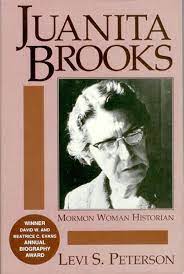Articles/Essays – Volume 22, No. 2
Mormon Woman Historian | Levi S. Peterson, Juanita Brooks: Mormon Woman Historian
Students of Utah and Mormon historiography ought to be rejoicing at the flowering of literature in that field over recent years. Beginning perhaps in the last decade with Wallace Stegner’s biography of Bernard DeVoto and his edited collection of De Voto’s letters, we have seen a succession of historiographical studies, including John Phillip Walker’s collection of Dale Morgan’s letters and Morgan’s fragmentary history of the early Mormon Church, the re cent brief survey of Mormon historiography by Davis Bitton and Leonard Arrington, and the happy news that Newell Bring hurst is preparing a biography of Fawn Brodie. It is now abundantly apparent that Levi S. Peterson has made a superb contribution to that growing literature with this exhaustive biography of Juanita Brooks.
In singing the praises of this fine book, it is difficult to overemphasize the almost unique appropriateness of Peterson as the biographer of Juanita Brooks. The pro found interest, not to say obsession, that Peterson has exhibited for many years with her life and works grows, it seems, from two fundamental common elements in their lives. One is that both grew up in small rural communities on the very frontier of Mormondom where paradoxical mixtures of zealotry and liberalism, earthiness and piety, created tensions in the way they view life, tensions they have attempted to resolve through extraordinary literary and public careers. The other is their common identification with “liberal Mormonism,” whose modern focal points have been such publications as DIALOGUE and Sunstone and informal study groups such as those led by Will and Juanita Brooks in Salt Lake City and St. George.
The first half of the biography is inevitably the best, for it deals with the period of Juanita’s life when those tensions were created and resolved most strongly. Peter son’s empathy for rural Mormon folkways and the general tenor of life in such com munities, his energy in seeking out fresh sources for largely unknown episodes in his subject’s girlhood, and the fortunate existence of elaborate documentation in the form of Quicksand and Cactus and other early autobiographical writings give an extraordinary richness to the narrative. He appropriately gives major attention to the awakening of her intellectual life primarily through her close study of the pioneer diaries she collected under government programs during the 1930s and through her correspondence with Dale Morgan. The fruit of that intellectual maturation was the great literary monuments of her middle years: her study of the Mountain Meadows Massacre, the biography of John D. Lee, and her editions of the Lee and Hosea Stout diaries.
The later chapters become increasingly tedious as her physical and intellectual powers diminished, as she turned her attentions to literary projects of secondary or even dubious value, and as humdrum family and professional concerns came to dominate her life. In dramatic terms, there is surely nothing less engrossing than the de tails of the daily life of a Mormon house wife, even a Mormon housewife with a 200 I.Q., particularly in contrast with the salad days when she strode into the office of David O. McKay to make an eloquent case for access to affidavits relating to the Mountain Meadows Massacre, or crossed swords with the ferocious Kate B. Carter over the objective presentation of Mormon history. But Juanita Brooks was, as Sterling McMurrin observed, “a most uncommon woman draped in a very common exterior,” and such humdrum details remind us how very common that exterior, and indeed much of her interior, really was.
Peterson’s objectivity, in the best spirit of Juanita Brooks herself, will not let even her squeak by with a courteous “A” when she deserves a “C minus,” and he is gently but firmly critical of the perfunctory projects of her later years. One happy circumstance in Peterson’s sharp-eyed coverage of those years, however, is that the friends and editors who helped pick up the slack in her personal and professional life as her powers began to diminish receive their due at last.
The last two or three pages of the book, where Peterson describes Brooks’s current unfortunate physical and mental circumstances and, in the third person, his own recent visit to her home and bedside, are extremely touching and unforgettable. As he concludes the book with an overall appraisal of her historical and cultural importance, though, one wonders if he does not slip into wishful thinking. “Because of her,” he writes, “the collective mind of Mormondom is more liberal and more at peace with itself than it might be otherwise” (p. 422). One has to wonder where the locus of that collective mind exists: at 50 East North Temple? At the offices of DIALOGUE, Sunstone, or Signature Books? Some Mormons certainly regarded her Mountain Meadows Massacre as a welcome dose of honesty in the otherwise almost exclusively faith-promoting historiography of the Church. Others, perhaps even most Latter-day Saints, clearly did not: how widely utilized are any of her books, for example, in the Church educational system? Mormon historians have gradually found it possible to express themselves more freely since 1950, partly, no doubt because of the appearance of her book in that year, but the “collective mind of Mormondom,” statistically at least, still seems overwhelmingly to prefer the torrent of defensive and faith-promoting literature that floods the shelves of Deseret Book outlets.
Juanita Brooks: Mormon Woman Historian by Levi S. Peterson (Salt Lake City: University of Utah Press, 1988), xi, 528 pp., $19.95.


 Back to full Issue
Back to full Issue

